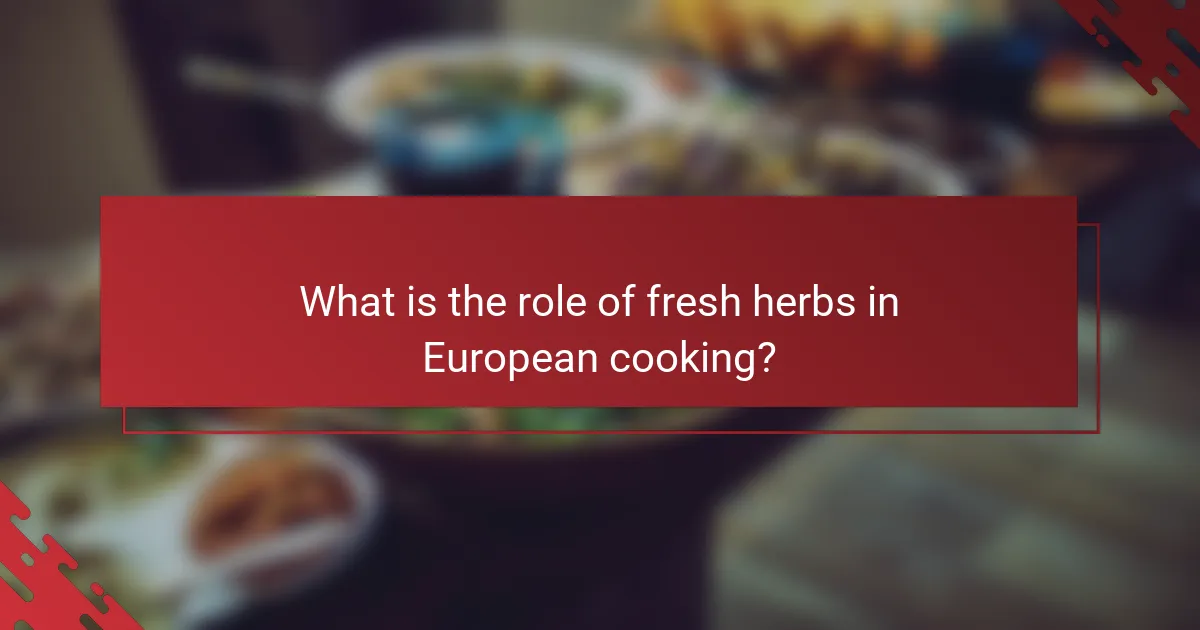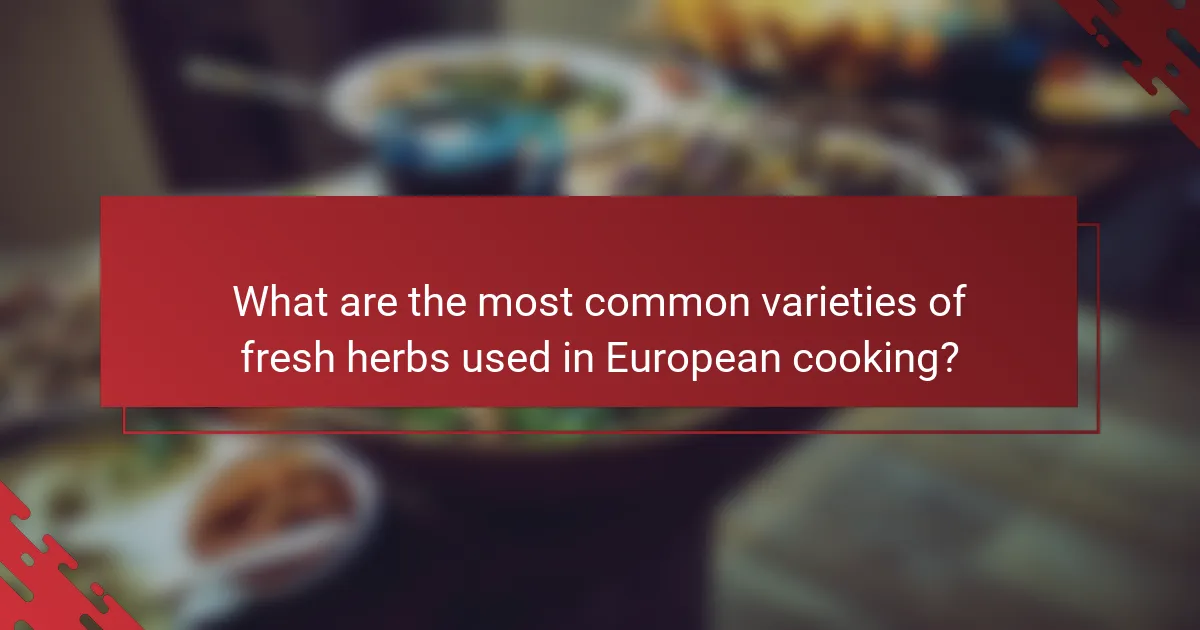Fresh herbs are essential components in European cooking, enhancing the flavor and aroma of a variety of dishes. Common varieties include basil, parsley, thyme, rosemary, and oregano, each contributing unique tastes that complement diverse ingredients. The article explores how these herbs are utilized in culinary practices, from early incorporation for flavor infusion to late addition for preserving freshness. Additionally, it highlights the nutritional benefits of fresh herbs, such as their antioxidant properties, and discusses their role in promoting healthier cooking by reducing the need for salt and fat. Overall, fresh herbs represent a vital aspect of traditional European cuisine, reflecting a commitment to fresh, natural ingredients.

What is the role of fresh herbs in European cooking?
Fresh herbs play a crucial role in European cooking by enhancing flavor and aroma. They provide vibrant tastes that elevate dishes, making them more appealing. Common herbs include basil, thyme, parsley, and rosemary. Each herb contributes distinct flavors that complement various ingredients. For instance, basil is essential in Italian cuisine, especially in sauces and salads. Thyme is frequently used in French dishes, adding depth to meats and stews. Fresh herbs also offer health benefits, such as antioxidants and vitamins. Their use in European cooking reflects a deep culinary tradition that values fresh, natural ingredients.
How do fresh herbs enhance flavors in European dishes?
Fresh herbs enhance flavors in European dishes by adding aromatic qualities and depth. They introduce complex flavor profiles that elevate the overall taste. Herbs like basil, thyme, and rosemary contribute distinct, vibrant notes. For example, basil provides a sweet and peppery flavor, while thyme adds earthiness. The freshness of herbs balances rich ingredients, creating harmony in dishes. Additionally, herbs can complement or contrast other flavors, enhancing the overall culinary experience. Studies show that the use of fresh herbs can significantly improve sensory perceptions in food. This is evident in traditional recipes across various European cuisines, where herbs are integral to regional dishes.
What specific flavor profiles do different herbs contribute?
Basil contributes a sweet and slightly peppery flavor. It is commonly used in Italian dishes. Oregano offers a warm, aromatic, and slightly bitter taste. It is essential in Mediterranean cuisine. Rosemary has a strong, pine-like flavor with a hint of lemon. It pairs well with roasted meats. Thyme provides a subtle earthy and minty flavor. It enhances soups and stews. Parsley adds a fresh, grassy note. It is often used as a garnish. Cilantro has a bright, citrusy flavor. It is popular in various international dishes. Dill offers a distinct anise-like taste. It is commonly used in pickling and seafood dishes. Each herb brings unique characteristics that enhance culinary creations.
How do fresh herbs interact with other ingredients in cooking?
Fresh herbs enhance the flavors of other ingredients in cooking. They provide aromatic compounds that complement and elevate the overall taste of dishes. For example, basil pairs well with tomatoes, enhancing their sweetness. Likewise, rosemary adds depth to roasted meats and vegetables. Fresh herbs can also introduce freshness and brightness, balancing rich or fatty ingredients. Their volatile oils release during cooking, infusing dishes with their distinct flavors. Studies show that herbs like parsley and cilantro can improve the perception of saltiness, allowing for reduced sodium use. This interaction makes fresh herbs essential for achieving flavor complexity in European cuisine.
Why are fresh herbs important in traditional European cuisine?
Fresh herbs are important in traditional European cuisine for enhancing flavor and aroma. They provide a vibrant taste that elevates dishes. Common herbs like basil, thyme, and rosemary are staples in many recipes. These herbs are often used fresh to maintain their essential oils and flavors. Fresh herbs also add nutritional benefits, including vitamins and antioxidants. Historically, their use dates back centuries, influencing regional cooking styles. In Mediterranean cuisine, for example, fresh herbs are central to flavor profiles. Their importance is reflected in traditional recipes that prioritize fresh ingredients for authentic taste.
What historical significance do fresh herbs hold in European cooking?
Fresh herbs have significant historical importance in European cooking. They have been used since ancient times to enhance flavors and preserve food. In ancient Rome, for instance, herbs like thyme and rosemary were valued for their medicinal properties and culinary uses. The Middle Ages saw a rise in the use of herbs for flavoring, as well as for their supposed health benefits. Culinary texts from this period often included extensive lists of herbs, indicating their central role in cooking. During the Renaissance, the cultivation of herbs became more widespread, leading to greater variety and accessibility in European kitchens. The use of fresh herbs continues to be a staple in modern European cuisine, reflecting their deep-rooted significance in culinary traditions.
How have culinary practices involving herbs evolved over time?
Culinary practices involving herbs have evolved significantly over time. In ancient civilizations, herbs were primarily used for medicinal purposes. As societies advanced, the culinary application of herbs became more prominent. The Middle Ages saw a rise in the use of herbs to enhance flavor in dishes. During this period, herbs like thyme and rosemary became staples in European kitchens. The Renaissance further popularized herbs in cooking, as exploration introduced new varieties from distant lands. The 18th and 19th centuries marked the emergence of herb gardens, allowing for fresh access to various herbs. Today, culinary practices emphasize the use of fresh herbs for their flavor and health benefits. This evolution reflects changing tastes and increased knowledge of herbs’ culinary potential.

What are the most common varieties of fresh herbs used in European cooking?
The most common varieties of fresh herbs used in European cooking include basil, parsley, thyme, rosemary, and oregano. Basil is often used in Italian dishes, particularly in sauces and salads. Parsley is a versatile herb used in various cuisines for garnishing and flavoring. Thyme is frequently added to meats and stews for depth of flavor. Rosemary is known for its strong aroma and is often used with roasted dishes. Oregano is a staple in Mediterranean cooking, especially in tomato-based recipes. These herbs are foundational in enhancing the flavors of traditional European recipes.
Which herbs are staples in various European cuisines?
Basil, parsley, thyme, rosemary, and dill are staples in various European cuisines. Basil is widely used in Italian cooking, especially in pesto and sauces. Parsley is a common garnish and flavoring in Mediterranean and Eastern European dishes. Thyme is essential in French cuisine, often used in stews and sauces. Rosemary is favored in Italian and Spanish cooking, enhancing meats and potatoes. Dill is prevalent in Scandinavian dishes, particularly in pickles and fish preparations. These herbs contribute distinct flavors and aromas, making them integral to the culinary traditions across Europe.
What are the key characteristics of basil, parsley, and thyme?
Basil, parsley, and thyme are distinct culinary herbs with unique characteristics. Basil is known for its aromatic leaves and sweet, peppery flavor. It thrives in warm climates and is commonly used in Mediterranean dishes. Parsley features bright green, flat or curly leaves and a mild, fresh taste. It is versatile and often used as a garnish or flavor enhancer. Thyme has small, delicate leaves and a strong, earthy flavor. It is a staple in French cuisine and pairs well with meats and stews. Each herb contributes unique flavors and aromas to a variety of dishes, enhancing the overall culinary experience.
How do regional variations affect the use of herbs in Europe?
Regional variations significantly affect the use of herbs in Europe. Different climates and soils influence herb growth and availability. For instance, Mediterranean regions favor herbs like basil and oregano. Conversely, northern European climates support herbs such as dill and chives. Local culinary traditions also dictate herb usage. In Italy, herbs enhance pasta dishes, while in Scandinavia, they flavor fish and root vegetables. Historical trade routes further diversified herb use across regions. This results in unique regional cuisines that reflect local herb preferences and growing conditions.
What lesser-known herbs are gaining popularity in European cooking?
Lesser-known herbs gaining popularity in European cooking include sorrel, lovage, and lemon balm. Sorrel is appreciated for its tangy flavor, often used in soups and salads. Lovage has a strong celery-like taste, enhancing stews and stocks. Lemon balm provides a citrusy aroma, commonly used in teas and desserts. These herbs are increasingly featured in modern recipes, reflecting a trend towards diverse flavors in European cuisine. Their unique profiles allow chefs to create innovative dishes that stand out.
What unique flavors do these herbs bring to dishes?
Fresh herbs bring distinct and vibrant flavors to dishes. Basil offers a sweet, peppery taste, enhancing Italian cuisine. Oregano provides a warm, slightly bitter flavor, ideal for Mediterranean dishes. Thyme has an earthy, minty profile, complementing roasted meats and vegetables. Parsley adds a fresh, grassy note, brightening up various recipes. Rosemary delivers a strong, pine-like flavor, perfect for hearty meals. Dill offers a tangy, slightly sweet flavor, commonly used in pickles and fish dishes. Each herb contributes unique characteristics, elevating the overall taste experience in European cooking.
How can chefs experiment with these herbs in modern recipes?
Chefs can experiment with herbs in modern recipes by incorporating them in novel ways. They can use fresh herbs in unexpected dishes, such as adding basil to desserts. Chefs may also create herb-infused oils or vinegars for unique flavor profiles. Another approach is to blend herbs into sauces or dressings for enhanced taste. Experimenting with herb pairings can yield interesting flavor combinations. For example, rosemary and lemon can complement grilled meats well. Chefs can also use herbs as garnishes to elevate presentation. Additionally, they may explore various cooking techniques, like grilling or smoking herbs, to intensify their flavors. These methods allow chefs to innovate while respecting traditional European culinary practices.

How can fresh herbs be used effectively in culinary applications?
Fresh herbs can be used effectively in culinary applications to enhance flavor and aroma. They can be added to dishes at different stages of cooking. Adding herbs early allows their flavors to infuse into the dish. Adding them towards the end preserves their fresh taste and vibrant color.
Common fresh herbs include basil, parsley, thyme, and rosemary. Each herb has distinct flavor profiles that complement various cuisines. For instance, basil pairs well with tomatoes, while rosemary enhances roasted meats. Herbs can also be used in marinades, dressings, and sauces for added depth.
Using fresh herbs can elevate the nutritional value of meals. They are rich in antioxidants and essential vitamins. Studies show that incorporating herbs can reduce the need for salt and fat, promoting healthier cooking practices.
What are the best methods for incorporating fresh herbs into recipes?
The best methods for incorporating fresh herbs into recipes include adding them at different stages of cooking. Adding herbs early in the cooking process allows their flavors to infuse into the dish. For example, thyme or rosemary can enhance soups and stews when added at the beginning. Adding herbs towards the end preserves their fresh flavor and vibrant color. Basil and parsley are ideal for this method in sauces and salads. Chopping herbs finely releases their essential oils, maximizing flavor impact. Using whole sprigs can provide a milder flavor, as seen with bay leaves in slow-cooked dishes. Infusing oils or butters with herbs creates a flavorful base for various recipes. This technique is commonly used in Mediterranean cuisine to enhance dishes.
How does the timing of adding herbs affect flavor?
The timing of adding herbs significantly affects flavor. Adding herbs early in the cooking process allows their essential oils to infuse the dish. This results in a more pronounced and well-rounded flavor. Conversely, adding herbs at the end preserves their fresh taste and aromatic qualities. For example, basil and parsley are often added just before serving to maintain their vibrant flavor. In contrast, robust herbs like thyme or rosemary can withstand longer cooking times. This ability to alter flavor profiles based on timing is crucial in culinary practices.
What are some techniques for preserving the freshness of herbs?
Refrigeration is an effective technique for preserving the freshness of herbs. Placing herbs in a damp paper towel and sealing them in a plastic bag helps retain moisture. Another method involves storing herbs in a jar of water, similar to a bouquet. Covering the herbs loosely with a plastic bag can create a humid environment. Freezing herbs is also a popular technique. Chopping herbs and placing them in ice cube trays with olive oil preserves their flavor. Drying herbs can extend their shelf life. This can be done using air drying, a dehydrator, or an oven at low temperatures. Each of these methods helps maintain the flavor and aroma of herbs for longer periods.
What tips can enhance the use of fresh herbs in home cooking?
Use fresh herbs at the end of cooking for maximum flavor. Adding herbs too early can diminish their taste. Chop herbs finely to release their essential oils. This enhances their aromatic qualities. Pair herbs with complementary ingredients to elevate dishes. For example, basil goes well with tomatoes. Store herbs properly to maintain freshness. Keep them in water or wrap in a damp cloth. Experiment with different herb combinations to discover new flavors. This creative approach can lead to unique culinary experiences.
How can home cooks select and store fresh herbs for maximum flavor?
Home cooks can select fresh herbs by looking for vibrant color and firm leaves. They should avoid wilted or discolored herbs. Aroma is also a key indicator of freshness. Strong scents indicate maximum flavor potential. For storage, herbs should be kept in a cool, dry place. Wrapping them in a damp paper towel and placing them in a sealed bag can help maintain moisture. Alternatively, herbs can be stored upright in a jar with water, like cut flowers. This method can extend their freshness for up to two weeks. Proper selection and storage techniques significantly enhance the flavor of herbs in cooking.
What common mistakes should be avoided when using fresh herbs?
Common mistakes to avoid when using fresh herbs include overcooking them. Fresh herbs lose their flavor when exposed to high heat for too long. Another mistake is using dried herbs instead of fresh when the recipe calls for fresh. This substitution can significantly alter the dish’s flavor profile. Additionally, not washing fresh herbs properly can lead to grit and dirt in the food. It’s important to rinse them thoroughly before use. Not chopping herbs finely enough can also reduce their flavor impact. Properly chopped herbs release more essential oils, enhancing the dish. Finally, storing fresh herbs incorrectly can cause them to wilt or spoil. They should be kept in a cool, dry place or refrigerated in water.
The main entity of this article is fresh herbs and their role in European cooking. Fresh herbs are essential for enhancing flavor and aroma in various European dishes, with common varieties including basil, thyme, parsley, and rosemary. The article explores how these herbs contribute distinct flavor profiles, interact with other ingredients, and their historical significance in culinary traditions. Additionally, it discusses practical methods for incorporating fresh herbs into recipes, preserving their freshness, and common mistakes to avoid in their usage. Overall, the article provides a comprehensive overview of the importance and application of fresh herbs in European cuisine.